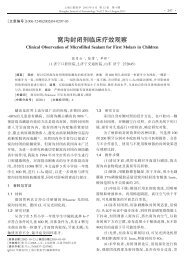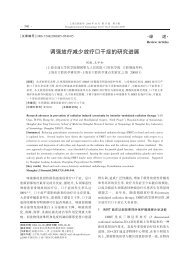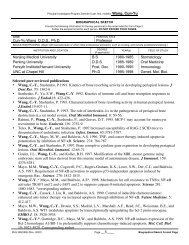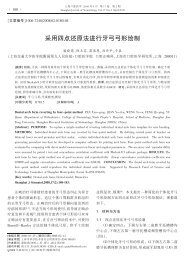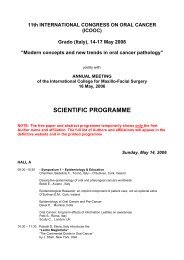core curriculum cleft lip/palate craniofacial anomalies
core curriculum cleft lip/palate craniofacial anomalies
core curriculum cleft lip/palate craniofacial anomalies
Create successful ePaper yourself
Turn your PDF publications into a flip-book with our unique Google optimized e-Paper software.
Core Curriculum for Cleft Palate and other Craniofacial Anomalies<br />
1. Sensorineural hearing loss. Children with <strong>cleft</strong> <strong>lip</strong>/<strong>palate</strong> and sensorineural<br />
hearing loss should be tested every 4-6 months in order to assess any<br />
progression of hearing loss and to make adjustments to amplification as<br />
needed for proper fit as the child grows.<br />
2. Conductive hearing loss. In cases of conductive hearing loss periodic<br />
assessment will assist the managing physician by providing feedback<br />
regarding the efficacy of treatment in achieving and maintaining normal<br />
hearing status.<br />
II.<br />
Genetics<br />
The geneticist is responsible for identifying the etiology and/or pathogenesis of the <strong>cleft</strong> or<br />
<strong>craniofacial</strong> anomaly. The information is then used to discuss overall prognosis for the<br />
patient as well as recurrence risk for the parents, patient, and other family members. As with<br />
other birth defects, <strong>cleft</strong>s and <strong>craniofacial</strong> disorders may be the result of chromosomal<br />
abnormalities, single gene disorders, and/or environmental factors/agents. Most commonly<br />
they are the result of multifactorial inheritance involving the interaction of an individual’s<br />
genetic background with the environment.<br />
Considerable progress has been made in the identification of causative factors over the past<br />
10 years particularly in the area of single gene disorders. The genes responsible for several<br />
of the most well known genetically determined syndromes have been recently identified.<br />
However, at the time of this writing, molecular testing is infrequently utilized in clinical<br />
management. Working drafts of the human genome sequence have recently been published<br />
in Nature and Science. Several surprises have emerged. The number of human genes<br />
(roughly 30,000) is far less than originally estimated. Through a variety of genetic<br />
mechanisms including alternative splicing and regulation of transcription, the 30,000 genes<br />
code for an enormously complex array of proteins. Clearly, biology is no longer “one gene –<br />
one protein.” It is now known that mutations in different genes may produce the same<br />
phenotype (e.g. FGFR1 and FGFR2 in Pfeiffer Syndrome). Different mutations in the same<br />
gene may result in different phenotypes (e.g. FGFR3 and achondroplasia,<br />
hypochondroplasia, thanatophoric dysplasia, and Crouzon Syndrome<br />
with acanthosis nigricans). The tissue distribution of a mutation may produce a range of<br />
phenotypes from a multisystem disorder to a tumor (e.g. GNAS1 and McCune-Albright<br />
Syndrome, fibrous dysplasia, and pituitary adenoma).<br />
With respect to environmental factors, there are some agents, such as with the acne drug,<br />
Accutane, which are potent human teratogens with a high risk for <strong>craniofacial</strong> malformation<br />
in prenatally exposed fetuses, regardless of the infant or mother’s genetic background. There<br />
are factors, such as cigarette smoking, that increase the risk for <strong>cleft</strong> <strong>lip</strong> with or without <strong>cleft</strong><br />
<strong>palate</strong> only in susceptible individuals. However, the genes that confer susceptibility to most<br />
<strong>cleft</strong> and <strong>craniofacial</strong> conditions remain to be elucidated. There is currently considerable<br />
interest in folic acid as a pre- or peri-conceptual treatment that might reduce the risk for <strong>cleft</strong><br />
<strong>lip</strong> and <strong>palate</strong> as it does for spina bifida. Further study is needed to confirm early reports.<br />
14<br />
© 2004 American Cleft Palate-Craniofacial Association




